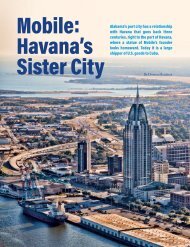You also want an ePaper? Increase the reach of your titles
YUMPU automatically turns print PDFs into web optimized ePapers that Google loves.
Home & Garden<br />
With the heat and frequent rains of summer, now is the best time of the year to<br />
plant new trees. And what better than the tropical flowering tree option? They<br />
are many and varied, and provide a magnificent point of interest in an elegant tropical<br />
garden. Just keep in mind to choose them not only for beauty, but for storm resistance,<br />
troublesome roots, and whether the tree is exceedingly messy. Meeting those<br />
criteria, here is a selection of the best. Just imagine any of these lining a driveway,<br />
street, or as an accent tree in the garden. You can combine colors and trees that blossom<br />
in different seasons to ensure your tropical paradise is always in color!<br />
1. Classic red royal poinciana, a Miami favorite for over a century<br />
2. Flowers, buds and cascading foliage of Colville’s glory<br />
3. Jacaranda cuspidifolia’s flower color differs based on soil pH<br />
4. The Long John tree, an underutilized tree with hot pink fruit<br />
5. Cassia fistula x javanica, a hybrid with yellow and pink in its blooms<br />
6. Ceylon Senna’s fall tropical color and shade<br />
THE TREE OF FIRE<br />
No mention of tropical trees is complete<br />
without the royal poinciana, Delonix regia.<br />
A Spanish name for it is Arbol del fuego,<br />
certainly more evocative of its hot tropical<br />
beauty. They’re a common sight along<br />
South Florida streets, and for good reason.<br />
They are drought tolerant once established,<br />
preferring very little water in winter, so<br />
are nearly maintenance free. They’re also<br />
tough; at Fairchild Tropical Botanic Garden,<br />
one planted in 1974 is thriving still.<br />
The flowers, of course, are what we<br />
are after. The umbrella-shaped poinciana is<br />
just afire with them in late spring, especially<br />
after a period of dry weather. Different<br />
trees range from crimson to reddish orange;<br />
there is even a golden yellow variety,<br />
Delonix regia var. flavida, and cultivars<br />
including ‘Kampong yellow’ and ‘Smathers<br />
gold.’ The fruit are woody seed pods a foot<br />
or so long, and a little messy. The roots<br />
are shallow and spreading, and the trunk<br />
produces buttresses, so plant the poinciana<br />
well away from structures.<br />
Tabebuia is shallow rooted and flowers<br />
in late spring after a winter dry season.<br />
Plant in full sun and they may reach 20-35<br />
feet. Tabebuia ‘Carib Queen’ is a hybrid to<br />
consider if you prefer deep magenta flowers.<br />
The tree will reach about 20 feet. For<br />
a splash of grape-purple try a Tibouchina.<br />
A smaller tree than Tabebuia (those in<br />
cultivation probably won’t exceed 15 feet),<br />
purple Tibouchina may flower throughout<br />
the year, more in warmer months. These<br />
trees prefer some shelter from the wind<br />
and the harshest midday sun, and some<br />
soil-acidifying fertilizer.<br />
STRAIGHT FROM MADAGASCAR<br />
Coleville’s glory (Colvillea racemosa), like<br />
the royal poinciana, is native to Madagascar.<br />
Unlike poinciana however, Colvillea is<br />
rare in cultivation. But it is well worth trying<br />
to find. Its foliage is pinnate like a fern,<br />
very wispy and fine, providing enchanting,<br />
dappled, rippling shade. Preferring full<br />
sun, Colvillea will reach 50 feet, a stunner<br />
with long, cone-shaped racemes – flowers<br />
attached along a stem – clustered with<br />
bright yellow and orange blooms that appear<br />
in fall. It truly is a glory, and drought<br />
tolerant!<br />
1<br />
2<br />
lia (pictured) for sale. The last can reach<br />
30 feet or so and seems to be the most<br />
common. It should flower in drier months,<br />
because it likes dry climates – anyone who<br />
has travelled through Spain has seen them<br />
flower profusely. The one pictured flowers<br />
in April, the tail end of Florida’s dry<br />
weather. Its foliage is feathery and fernlike,<br />
and its fruit are seedpods that look<br />
like 2- to 3-inch-long turtle shells. Needs<br />
direct sun.<br />
VERTICAL RED<br />
There don’t seem to be many Long John<br />
trees in private gardens, but Triplaris<br />
cummingiana (also called the ant tree)<br />
fits beautifully into areas of full sun to<br />
some shade; and like many of our trees, it<br />
prefers dry winters and wet summers. It<br />
flowers and fruits in winter, an unexpected<br />
delight. The Long John tree can attain 50<br />
feet and higher, but is more pyramidal and<br />
less spreading than royal poinciana, for<br />
example.<br />
SMALLER TREES<br />
Finally come the cassias, slightly smaller<br />
tropical trees. There’s a good deal of variability<br />
in some Cassia species with hybrids<br />
available. Cassia fistula x javanica, the<br />
rainbow shower tree, is one such hybrid.<br />
Its parents produce yellow and pink flowers,<br />
so you may see a bit of both colors in<br />
this one. Thriving under full sun, it’ll reach<br />
about 20 feet maximum, and forms a nicely<br />
compact tree of colorful blossoms along<br />
racemes in spring and summer, fading to<br />
creamy white with age.<br />
CASCADING CANOPIES<br />
Cassia roxburghii, or Ceylon Senna, is<br />
native to Sri Lanka and southern India. It<br />
forms a large, cascading canopy up to 30<br />
GOLDEN AND PURPLE BELLS<br />
feet tall of fine, feathery foliage. When it<br />
Tabebuia species of trees (photo page 73)<br />
flowers in late summer/early fall (photo<br />
can produce shades of pink, magenta or<br />
taken in November), the deep pink and<br />
yellow flowers. The yellow is less cold tolerant,<br />
red flowers carpet the waterfall of weep-<br />
but more eye-catching. They seem to SPANISH PURPLE<br />
ing branches. It’s a wonderful shade tree,<br />
glow from within. Both Tabebuia chrysotricha<br />
Is it blue or purple? Opinions differ, but<br />
preferring full sun to part shade.<br />
and T. Aurea (Caribbean trumpet Jacaranda flowers are affected by soil<br />
We are lucky to also be able to grow<br />
tree) are yellow flowering, the latter more acidity, with more alkaline soil like ours in<br />
Cassia bakeriana, sometimes called the<br />
common. The flowers are bell shaped and South Florida producing shades toward<br />
pink shower tree. From Southeast Asia, it<br />
especially showy because the tree usually blue. You are likely to find Jacaranda<br />
prefers a sunny, sheltered area, but is worth<br />
sheds its leaves before flowering.<br />
mimosifolia, J. caerulea or J. cuspidifo- 3<br />
6<br />
it when the flowers appear.<br />
64 thecoralgablesmagazine.com<br />
Kenneth Setzer is a writer for Fairchild<br />
Tropical Botanic Garden<br />
65<br />
4<br />
5
















